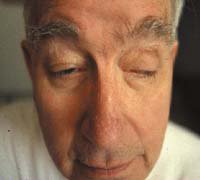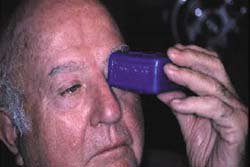Ice-pack, sleep exams simplify diagnosis of ocular myasthenia
Simple ways to spot the ocular effects of myasthenia are an improvement over the Tensilon test.
Click Here to Manage Email Alerts
PHILADELPHIA — New, simple and noninvasive tests for spotting and diagnosing ocular myasthenia can be performed in your office, according to a neuro-ophthalmologist in practice here.
“The most important office tests for ophthalmologists to be aware of today are the sleep and ice tests,” said Mark L. Moster, MD, of the Albert Einstein Medical Center here “These tests provide easier ways of diagnosing myasthenia, without the side effects of traditional tests and the need for high-tech machinery and diagnostic materials.”
According to Dr. Moster, myasthenia is a rare disease that has only recently — in the past 20 years — been studied and documented. Most cases present with ptosis and diplopia, which develop at the onset of the disease and can last throughout a lifetime.
“The average age of onset is 38 years for both men and women. However, there seems to be a peak in older men and younger women,” he said.
The condition is an autoimmune disorder that causes a weakness of muscles in the eye and can spread throughout the body, he added.
“For patients, 40% will have ocular symptoms for the whole course of the illness, and 10% will go into full remission. However, if a patient remains ocular for a full 3 years, there’s only a 10% to 20% chance that he or she will go into generalized myasthenia, which can affect your speech, swallowing, breathing and strength in the extremities,” Dr. Moster explained.
|
Features to look for
“The hallmarks of this illness are variability and fatigability. At different times during the day, or on different days, the exam will be different,” Dr. Moster said.
In myasthenia, the severity of the disorder fluctuates from morning to night. In the morning, there is less muscle fatigue than by the end of the day, when muscles have become overworked.
“The fatigability is best demonstrated on exam by prolonged upgaze. You have the patient looking up, but after 15 seconds you notice the eyelids straining, and after about a minute, there is progressive fatigue of the eyelid,” Dr. Moster said.
The most common finding in myasthenia is ptosis, which can affect the patient unilaterally or bilaterally.
“It may even shift sides, which is almost pathognomonic for myasthenia,” he added.
In some cases, paresis may occur, causing double vision.
|
Traditional testing problamatic
“The classic, traditional office test is a Tensilon test,” Dr. Moster said.
The Tensilon (edrophonium chloride, ICN Pharmaceuticals) test is usually performed when a patient shows a measurable degree of ptosis or a large motility defect. Typically, a weakness caused by myasthenia will improve after administration of the drug.
In the Tensilon test, the edrophonium chloride is given intravenously. However, sensitive patients — such as children and infants — are often incompatible with the intravenous mode of therapy, he said.
The single-fiber EMG test has been another method of choice in diagnostic testing for myasthenia. In this test a single fiber leading to two muscle cells is studied, to observe the frequency and abnormality of the muscle response, called jitter. This is a very sensitive test for myasthenia.
“Acetylcholine receptor antibodies are highly specific for myasthenia, but only 50% sensitive in ocular myasthenia,” Dr. Moster said.
Simple, noninvasive testing
| |
To avoid these complications, Dr. Moster recommends the sleep and ice-pack tests because they are noninvasive and safe and can be performed in a physician’s office.
“In the sleep test, you measure the deficit. Allow patients to sleep or rest with their eyes closed in a dark room for 30 minutes. If, when the patient gets up, there is resolution or notable improvement of symptoms, you know you have a case of myasthenia on your hands,” he said.
Ophthalmologists can also use an ice test to measure ptosis.
“Put an ice pack on the patient’s eyelid for 2 minutes. If ptosis is improved by 2 mm or more after ice, you have a case of myasthenia,” he said.
According to Dr. Moster, the ice test is 80% sensitive and even more specific. So if the patient’s ptosis responds positively to the ice-pack treatment, it is likely that the patient has myasthenia.
Treatment after diagnosis
“Once we’ve diagnosed myasthenia, we should check for thyroid disease, because 5% to 10% of patients have coexisting immune thyroid diseases, such as Grave’s disease or Hashimoto’s thyroiditis.
Medications to improve the symptoms of myasthenia include corticosteroid and cholinesterase inhibitors.
“Anticholinesterase drugs have a short action and only sometimes help with ocular myasthenia,” he said.
These drugs can also be associated with complications and side effects including gastrointestinal disorders and increased bronchial secretions.
“If you want to see strong, positive improvements, steroids are the way to go,” he explained.
According to Dr. Moster, 75% of patients on steroids improve their symptoms.
Dr. Moster advises starting patients with ocular myasthenia on a low-dose steroid and then increasing the dose once symptoms begin to resolve. Resolution of symptoms takes place over 6 to 8 weeks, and in the months to follow muscle strength may increase to total remission.
For Your Information:
- Mark L. Moster, MD, can be reached at Albert Einstein Medical Center, York and Tabor Roads, Philadelphia, PA 19141; (215) 456-7193; fax: (215) 456-7308; e-mail: mmoster@aol.com. Dr. Moster has no direct financial interest in the products mentioned in this article, nor is he a paid consultant for any companies mentioned.





